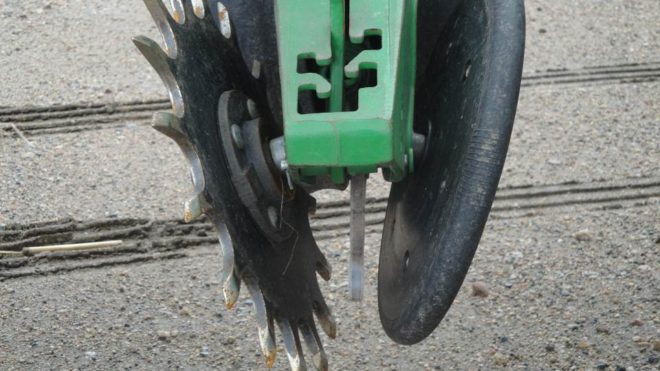The New Year is here! This is a great time to evaluate your current cropping program and decide the areas you can seek to improve in 2021. Planters are a key priority for us in Practical Farm Research (PFR). The planter pass sets the stage for the rest of the growing season; its success is vital for raising higher yields. PFR has tested planter attachments and aftermarket options.
Spike Closing Wheels
Our research consistently shoes that any spiked closing wheel is an update over two rubber closing wheels. Five closing wheels and three closing wheel systems have been designated PFR Proven for corn or soybeans. When planting conditions are not ideal, spiked closing wheels are an absolute must on every planter!
- Yetter Poly Twister – This Poly wheel is versatile and performs well regardless of tillage, soil type, or field conditions. The outer spiked ring can transform existing rubber closing wheels easily and cost-effectively.
- Schaffert Zipper – Incorporating a cast metal wheel with a sharper spike, this closing wheel helps work through existing crop residue and closes the seed trench. It’s a top pick for no-till scenarios.
#1 – PFR Practical Tip: All closing wheels are slightly different in how the manufacturer wants them installed. Be sure to pay attention to the orientation and spacing of the wheels during installation.
Automated Hydraulic Downforce
Downforce is one of the essential components of a planter, as it ensures proper seeding depth and bulk density around each seed. Too much downforce can result in sidewall compaction and poor root growth. Too little downforce and planting depth is compromised, which can lead to inconsistent emergence. The main advantage of an automated hydraulic downforce system is the ability to establish that the correct amount of downforce is applied on each row across every acre no matter the soil type, tillage practice, or field condition.
*Highly Recommended For: Anyone who encounters high variability in soil type, tillage practices, or planting conditions.
#2 – PFR Practical Tip: If an automated hydraulic downforce system isn’t in the budget for this year, consider installing weigh pins across the planter to monitor the amount of downforce that is applied and when changes need to be made in the field.
2x2x2
PFR has tested three different systems in our 2x2x2 studies. Regardless of the system used or the field where tested, we have found a consistent advantage to banding nutrients on both sides of the row. Split applying early-season nutrition evenly on both sides of the row, without burning the roots, has led to larger and more evenly developed root systems and higher yields. Our research shows a 2x2x2 fertilizer application is one of the most effective ways to deliver corn its needed early season nutrition, help butter against Mother Nature, and set the stage for higher yields.
*Highly Recommended For: Farmers who can manage the added logistics required at planting and want more consistency in pushing higher corn yields. It’s a great fit for farms that want to incorporate more sulfur and zinc in fertility programs.
#3 – PFR Practical Tip: The new dual banding systems only place nitrogen approximately 1.5 in. below the top of the ground to reduce downforce requirements. A placement of 2 in. to each side of the trench is recommended for adequate soil buffering and protection from salt injury.
Row Cleaners
Row cleaners are designed to move residue ahead of the row unit. This helps to mitigate hair pinning trash in the seed trench and enables the furrow to warm up faster. Row cleaner planter attachments made originally for no-tilling corn are now proving their adaptability and worthiness on soybeans. Although the greatest benefit will be captured in a no-till scenario, row cleaners are still advantageous on worked ground. Cleaners will move dirt clods, old root balls, and rocks aside to allow smoother row unit ride and operation. When deciding which row cleaners to invest in, be sure to select the style of row cleaners that best fit your scenario. Options exist for different row widths, tillage scenarios, and adjustment controls.
*Highly Recommended For: No-till conditions and/or operations that have rocks.
#4 – PFR Practical Tip: Consider upgrading to a system that will allow you to adjust the row cleaners quickly and easily from the cab. Proper adjustments as field conditions change will protect the optimum performance and return on your row cleaner investment.
High Speed Planting
Larger farming operations, combined with fewer and tighter planting windows in the spring, have brought about a greater efficiency need. One way to gain efficiency at planting is to plant faster. With high-speed planter attachments, PFR has observed increased planting speeds don’t sacrifice stand quality or yield. The concept behind high-speed planting is to replace the standard seed tube, where gravity delivers the seed, with a system that will mechanically deliver the seed to the furrow. SpeedTube delivers the seed down to the bottom of the furrow at the same speed in which the planter is moving forward thus, eliminating the chance for the seed to bounce or ricochet away from where it should be placed.
*Highly Recommended For: Farmers that need to increase planted acres/hour or operators that are seeking a true ‘picket fence’ corn stand.
#5 – PFR Practical Tip: Reactive hydraulic downforce is a must for high-speed planting. The faster you go, the more downforce required to keep the row unit in the ground and maintain the desired planting depth. Also, as planting speed increase, horsepower requirements increase substantially. Make sure you have plenty of tractor!
Like most things in agriculture, there isn’t a silver bullet solution or one ‘perfect planter setup’ that fits every operation. When considering which options to invest in, remember to focus on the areas you feel need the most attention.
~ Jared Chester – Ohio PFR Location Lead

